tow Citroen C4 AIRCROSS RHD 2014.5 1.G Owner's Guide
[x] Cancel search | Manufacturer: CITROEN, Model Year: 2014.5, Model line: C4 AIRCROSS RHD, Model: Citroen C4 AIRCROSS RHD 2014.5 1.GPages: 389, PDF Size: 15.51 MB
Page 143 of 389
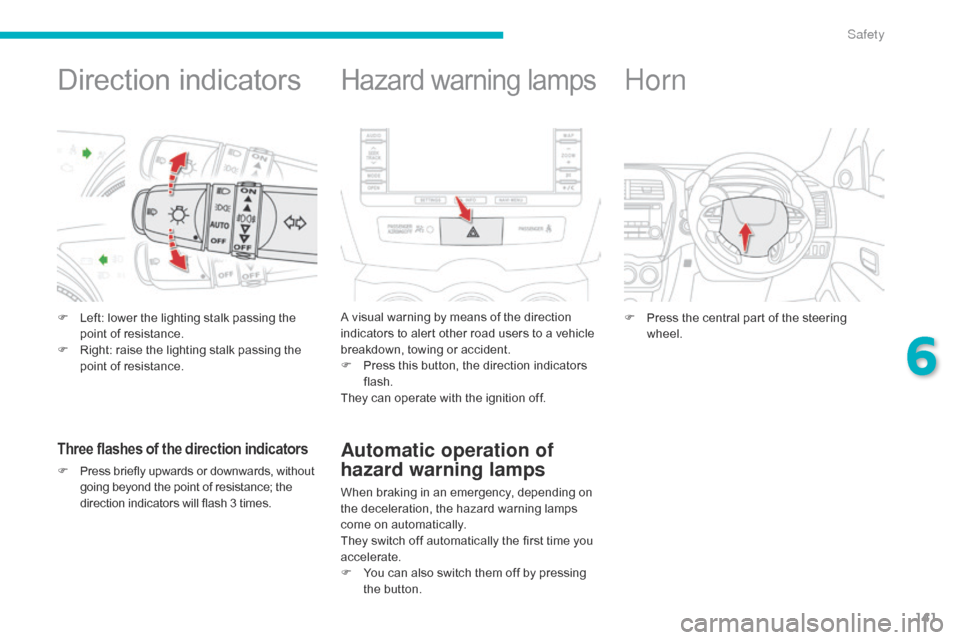
141
Direction indicators
F Left: lower the lighting stalk passing the point of resistance.
F
R
ight: raise the lighting stalk passing the
point of resistance.
Three flashes of the direction indicators
F Press briefly upwards or downwards, without going beyond the point of resistance; the
direction indicators will flash 3 times.
Hazard warning lamps
A visual warning by means of the direction
indicators to alert other road users to a vehicle
breakdown, towing or accident.
F
P
ress this button, the direction indicators
flash.
They can operate with the ignition off.
Automatic operation of
hazard warning lamps
When braking in an emergency, depending on
the deceleration, the hazard warning lamps
come on automatically.
They switch off automatically the first time you
accelerate.
F
Y
ou can also switch them off by pressing
the button.
Horn
F Press the central part of the steering wheel.
6
Safety
Page 150 of 389
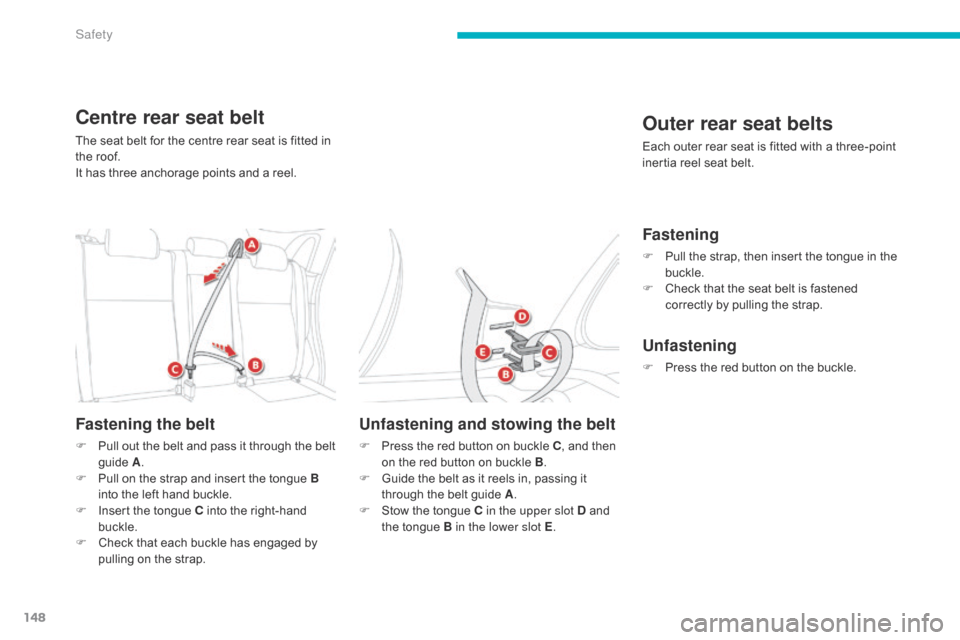
148
Centre rear seat belt
The seat belt for the centre rear seat is fitted in
the roof.
It has three anchorage points and a reel.
Fastening the belt
F Pull out the belt and pass it through the belt guide A.
F
P
ull on the strap and insert the tongue B
into the left hand buckle.
F
I
nsert the tongue C into the right-hand
buckle.
F
C
heck that each buckle has engaged by
pulling on the strap.
Unfastening and stowing the belt
F Press the red button on buckle C , and then
on the red button on buckle B .
F
G
uide the belt as it reels in, passing it
through the belt guide A .
F
S
tow the tongue C in the upper slot D and
the tongue B in the lower slot E .
Outer rear seat belts
Each outer rear seat is fitted with a three-point
inertia reel seat belt.
Fastening
F Pull the strap, then insert the tongue in the
buckle.
F
C
heck that the seat belt is fastened
correctly by pulling the strap.
Unfastening
F Press the red button on the buckle.
Safety
Page 151 of 389
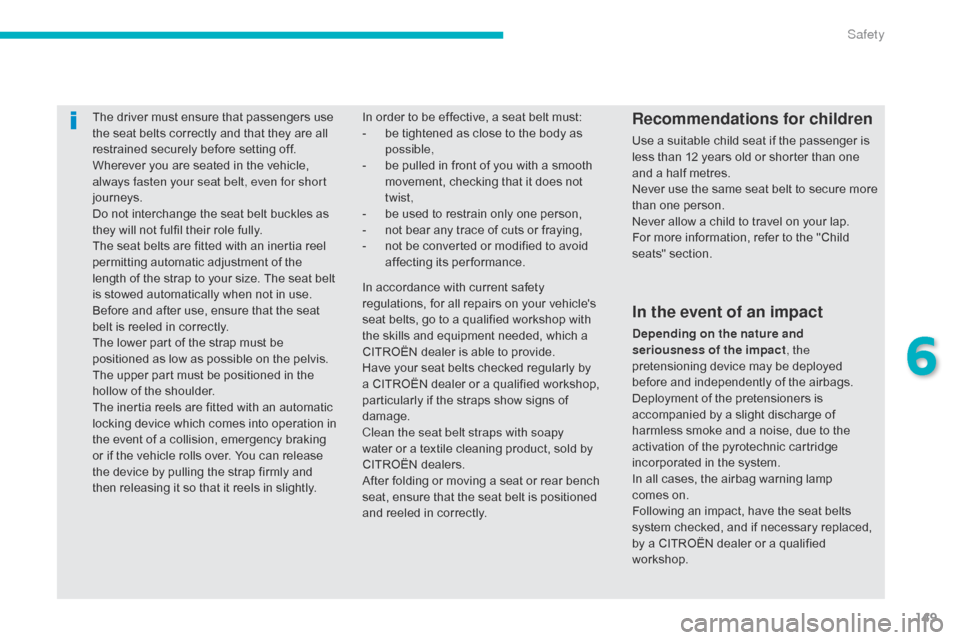
149
The driver must ensure that passengers use
the seat belts correctly and that they are all
restrained securely before setting off.
Wherever you are seated in the vehicle,
always fasten your seat belt, even for short
journeys.
Do not interchange the seat belt buckles as
they will not fulfil their role fully.
The seat belts are fitted with an inertia reel
permitting automatic adjustment of the
length of the strap to your size. The seat belt
is stowed automatically when not in use.
Before and after use, ensure that the seat
belt is reeled in correctly.
The lower part of the strap must be
positioned as low as possible on the pelvis.
The upper part must be positioned in the
hollow of the shoulder.
The inertia reels are fitted with an automatic
locking device which comes into operation in
the event of a collision, emergency braking
or if the vehicle rolls over. You can release
the device by pulling the strap firmly and
then releasing it so that it reels in slightly.Recommendations for children
Use a suitable child seat if the passenger is
less than 12 years old or shorter than one
and a half metres.
Never use the same seat belt to secure more
than one person.
Never allow a child to travel on your lap.
For more information, refer to the "Child
seats" section.
In order to be effective, a seat belt must:
-
b
e tightened as close to the body as
possible,
-
b
e pulled in front of you with a smooth
movement, checking that it does not
twist,
-
b
e used to restrain only one person,
-
n
ot bear any trace of cuts or fraying,
-
n
ot be converted or modified to avoid
affecting its performance.
In the event of an impact
Depending on the nature and
seriousness of the impact , the
pretensioning device may be deployed
before and independently of the airbags.
Deployment of the pretensioners is
accompanied by a slight discharge of
harmless smoke and a noise, due to the
activation of the pyrotechnic cartridge
incorporated in the system.
In all cases, the airbag warning lamp
comes
on.
Following an impact, have the seat belts
system checked, and if necessary replaced,
by a CITROËN dealer or a qualified
workshop.
In accordance with current safety
regulations, for all repairs on your vehicle's
seat belts, go to a qualified workshop with
the skills and equipment needed, which a
CITROËN dealer is able to provide.
Have your seat belts checked regularly by
a CITROËN dealer or a qualified workshop,
particularly if the straps show signs of
damage.
Clean the seat belt straps with soapy
water or a textile cleaning product, sold by
CITROËN dealers.
After folding or moving a seat or rear bench
seat, ensure that the seat belt is positioned
and reeled in correctly.
6
Safety
Page 152 of 389
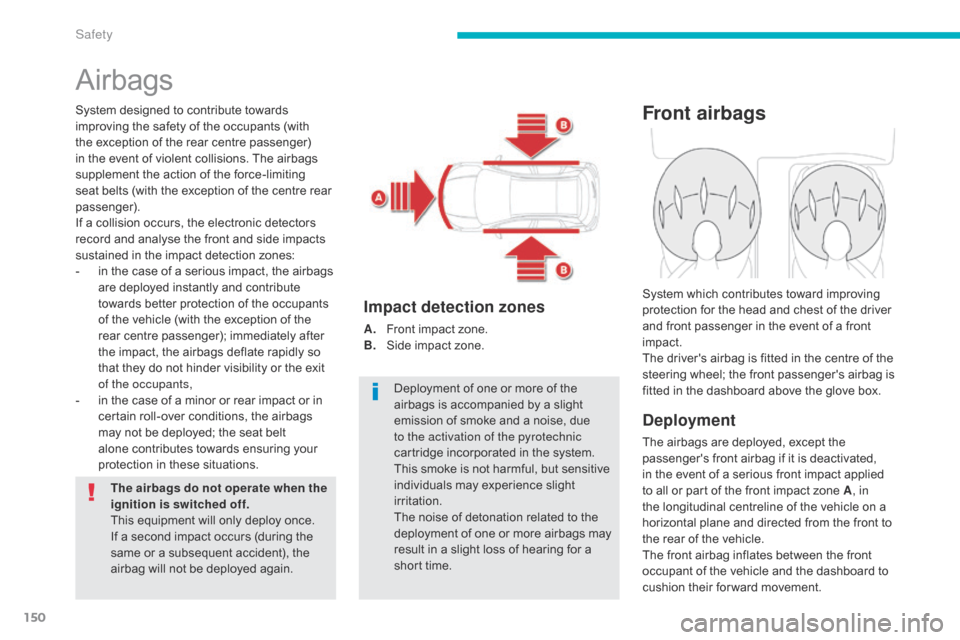
150
Airbags
System designed to contribute towards
improving the safety of the occupants (with
the exception of the rear centre passenger)
in the event of violent collisions. The airbags
supplement the action of the force-limiting
seat belts (with the exception of the centre rear
passenger).
If a collision occurs, the electronic detectors
record and analyse the front and side impacts
sustained in the impact detection zones:
-
i
n the case of a serious impact, the airbags
are deployed instantly and contribute
towards better protection of the occupants
of the vehicle (with the exception of the
rear centre passenger); immediately after
the impact, the airbags deflate rapidly so
that they do not hinder visibility or the exit
of the occupants,
-
i
n the case of a minor or rear impact or in
certain roll-over conditions, the airbags
may not be deployed; the seat belt
alone contributes towards ensuring your
protection in these situations.
The airbags do not operate when the
ignition is switched off.
This equipment will only deploy once.
If a second impact occurs (during the
same or a subsequent accident), the
airbag will not be deployed again. Deployment of one or more of the
airbags is accompanied by a slight
emission of smoke and a noise, due
to the activation of the pyrotechnic
cartridge incorporated in the system.
This smoke is not harmful, but sensitive
individuals may experience slight
irritation.
The noise of detonation related to the
deployment of one or more airbags may
result in a slight loss of hearing for a
short time.
Impact detection zones
A. Front impact zone.
B. S
ide impact zone.
Front airbags
Deployment
The airbags are deployed, except the
passenger's front airbag if it is deactivated,
in the event of a serious front impact applied
to all or part of the front impact zone A , in
the longitudinal centreline of the vehicle on a
horizontal plane and directed from the front to
the rear of the vehicle.
The front airbag inflates between the front
occupant of the vehicle and the dashboard to
cushion their for ward movement. System which contributes toward improving
protection for the head and chest of the driver
and front passenger in the event of a front
impact.
The driver's airbag is fitted in the centre of the
steering wheel; the front passenger's airbag is
fitted in the dashboard above the glove box.
Safety
Page 154 of 389
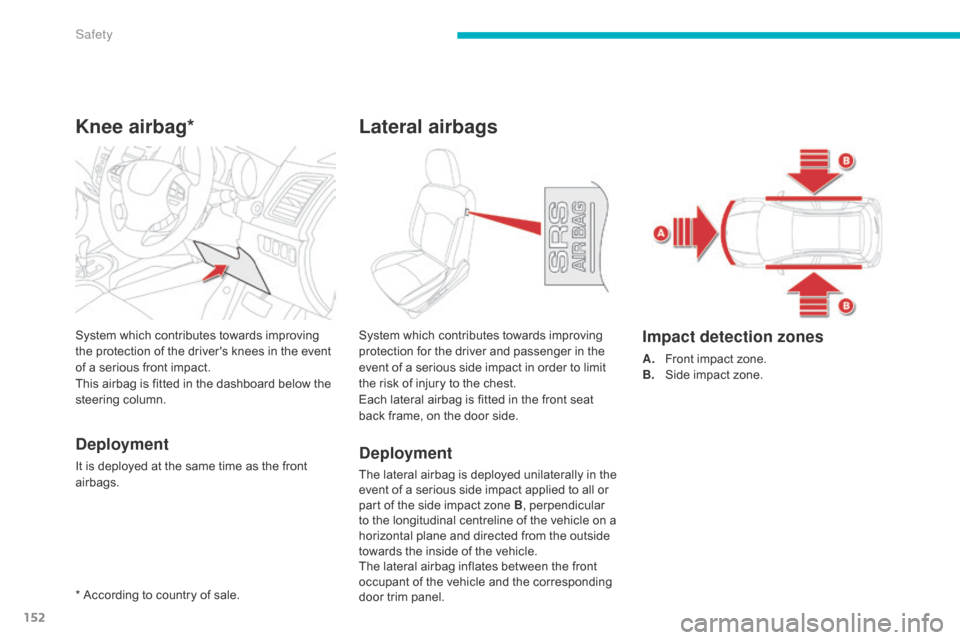
152
Knee airbag*
Deployment
It is deployed at the same time as the front
airbags. System which contributes towards improving
the protection of the driver's knees in the event
of a serious front impact.
This airbag is fitted in the dashboard below the
steering column.System which contributes towards improving
protection for the driver and passenger in the
event of a serious side impact in order to limit
the risk of injury to the chest.
Each lateral airbag is fitted in the front seat
back frame, on the door side.Deployment
The lateral airbag is deployed unilaterally in the
event of a serious side impact applied to all or
part of the side impact zone B, perpendicular
to the longitudinal centreline of the vehicle on a
horizontal plane and directed from the outside
towards the inside of the vehicle.
The lateral airbag inflates between the front
occupant of the vehicle and the corresponding
door trim panel.
Impact detection zones
A. Front impact zone.
B. S
ide impact zone.
* According to country of sale.
Lateral airbags
Safety
Page 155 of 389
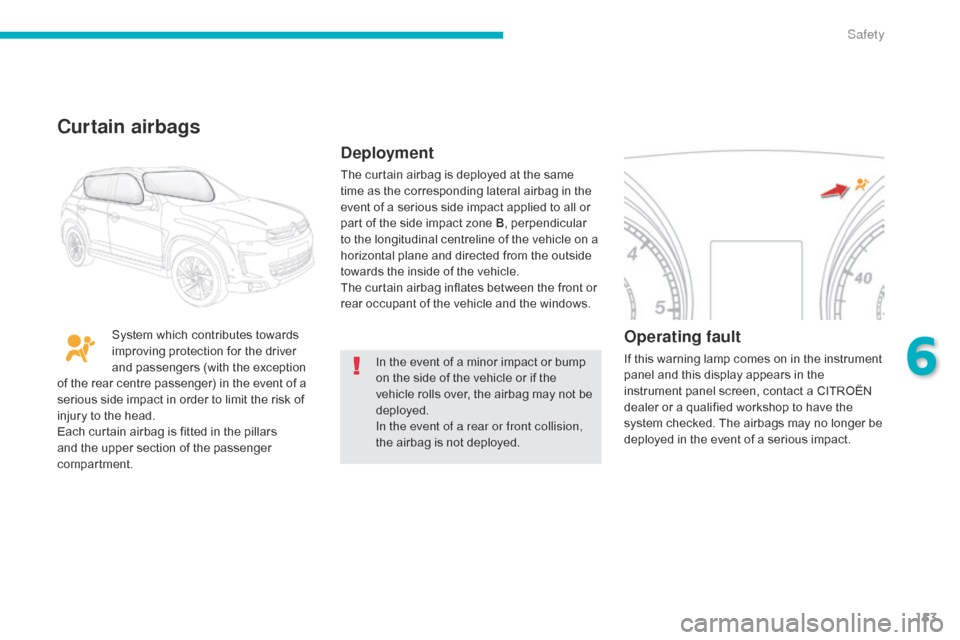
153
In the event of a minor impact or bump
on the side of the vehicle or if the
vehicle rolls over, the airbag may not be
deployed.
In the event of a rear or front collision,
the airbag is not deployed.
System which contributes towards
improving protection for the driver
and passengers (with the exception
of the rear centre passenger) in the event of a
serious side impact in order to limit the risk of
injury to the head.
Each curtain airbag is fitted in the pillars
and the upper section of the passenger
compartment.
Curtain airbags
Deployment
The curtain airbag is deployed at the same
time as the corresponding lateral airbag in the
event of a serious side impact applied to all or
part of the side impact zone B, perpendicular
to the longitudinal centreline of the vehicle on a
horizontal plane and directed from the outside
towards the inside of the vehicle.
The curtain airbag inflates between the front or
rear occupant of the vehicle and the windows.
Operating fault
If this warning lamp comes on in the instrument
panel and this display appears in the
instrument panel screen, contact a CITROËN
dealer or a qualified workshop to have the
system checked. The airbags may no longer be
deployed in the event of a serious impact.
6
Safety
Page 165 of 389
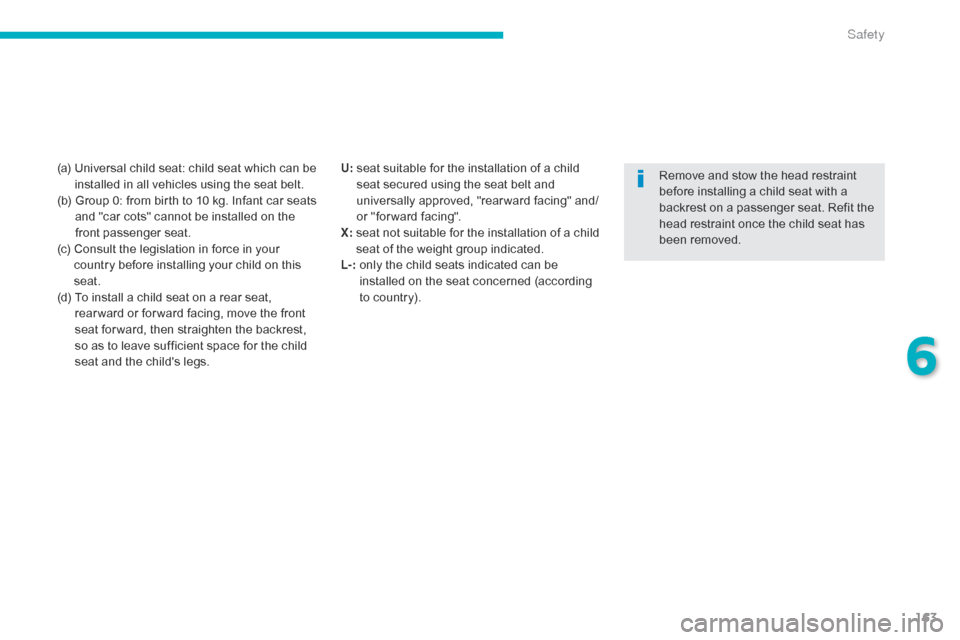
163
(a) Universal child seat: child seat which can be installed in all vehicles using the seat belt.
(b)
G
roup 0: from birth to 10 kg. Infant car seats
and "car cots" cannot be installed on the
front passenger seat.
(c)
C
onsult the legislation in force in your
country before installing your child on this
seat.
(d)
T
o install a child seat on a rear seat,
rear ward or for ward facing, move the front
seat for ward, then straighten the backrest,
so as to leave sufficient space for the child
seat and the child's legs. Remove and stow the head restraint
before installing a child seat with a
backrest on a passenger seat. Refit the
head restraint once the child seat has
been removed.
U:
s eat suitable for the installation of a child
seat secured using the seat belt and
universally approved, "rear ward facing" and/
or "for ward facing".
X:
s
eat not suitable for the installation of a child
seat of the weight group indicated.
L-:
o
nly the child seats indicated can be
installed on the seat concerned (according
to country).
6
Safety
Page 167 of 389
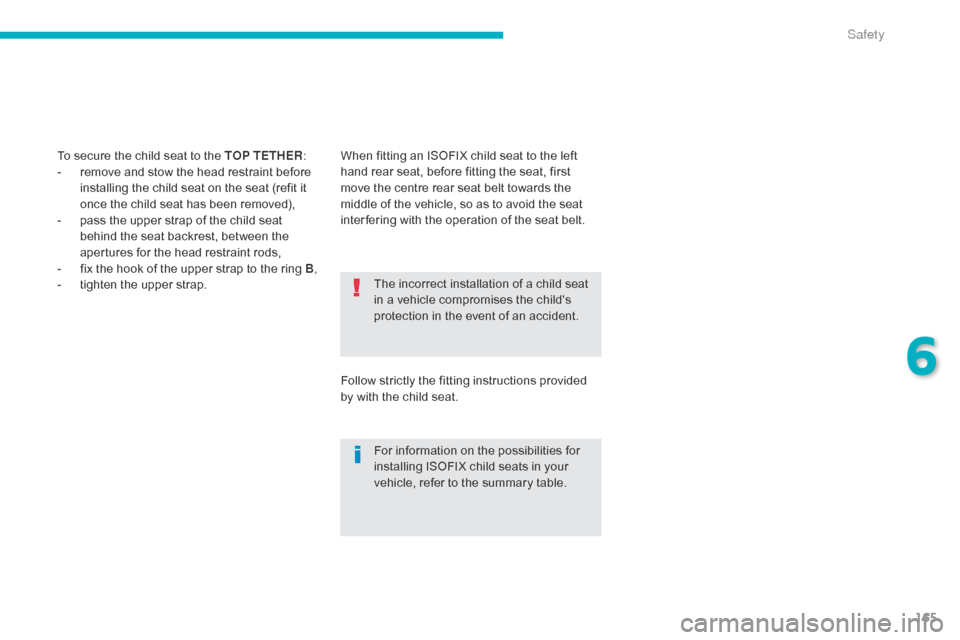
165
The incorrect installation of a child seat
in a vehicle compromises the child's
protection in the event of an accident.
For information on the possibilities for
installing ISOFIX child seats in your
vehicle, refer to the summary table.
To secure the child seat to the TOP TETHER
:
-
r
emove and stow the head restraint before
installing the child seat on the seat (refit it
once the child seat has been removed),
-
p
ass the upper strap of the child seat
behind the seat backrest, between the
apertures for the head restraint rods,
-
f
ix the hook of the upper strap to the ring B,
-
t
ighten the upper strap. When fitting an ISOFIX child seat to the left
hand rear seat, before fitting the seat, first
move the centre rear seat belt towards the
middle of the vehicle, so as to avoid the seat
inter fering with the operation of the seat belt.
Follow strictly the fitting instructions provided
by with the child seat.
6
Safety
Page 170 of 389

168
Locations for ISOFIX child seats
In accordance with European Regulations, this table indicates the options for installing ISOFIX child seats on seats in the vehicle fitted with ISOFIX
mountings.
In the case of universal and semi-universal ISOFIX child seats, the ISOFIX size category, determined by a letter between A and G, is indicated on the
child seat next to the ISOFIX logo.
Weight of the child / indicative age
Less than 10 kg (group 0)
Up to approx. 6
monthsLess than 10 kg
(group 0)
Less than 13 kg
(group 0+)
Up to approx. 1 year From 9 to 18 kg (group 1)
From approx. 1 to 3 years
Type of ISOFIX child seat infant car seat "rearward facing"
"rearward facing""forward facing"
ISOFIX size categor y F G C D E C D A B B1
Universal and semi-universal ISOFIX child
seats which can be installed on the outer
rear seat s X
XI L1IL2 X IUF
I UF:
s
eat suitable for the installation of an I sofix Universal seat, " For ward facing" secured using the
"Top Tether" upper strap.
IL-:
o
nly the child seats indicated can be installed using the ISOFIX mountings.
For advice on securing of the "Top Tether" upper strap, refer to the "ISOFIX mountings" section.
X: seat not suitable for the installation of an ISOFIX seat of the size category indicated. Remove and stow the head restraint
before installing a child seat with a
backrest on a passenger seat. Refit the
head restraint once the child seat has
been removed.
Safety
Page 172 of 389
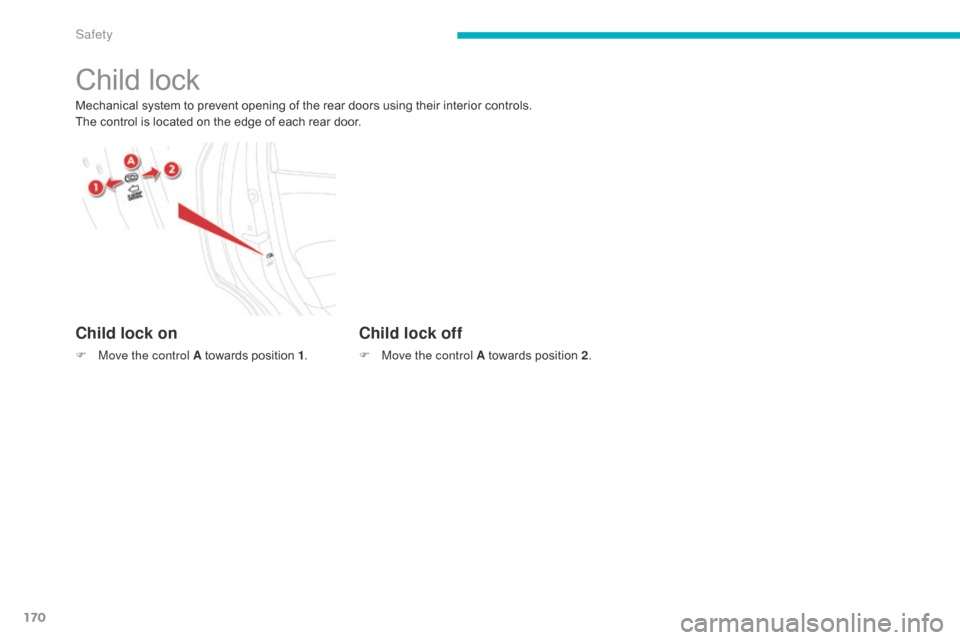
170
Child lock
Mechanical system to prevent opening of the rear doors using their interior controls.
The control is located on the edge of each rear door.
Child lock on
F Move the control A towards position 1.
Child lock off
F Move the control A towards position 2 .
Safety